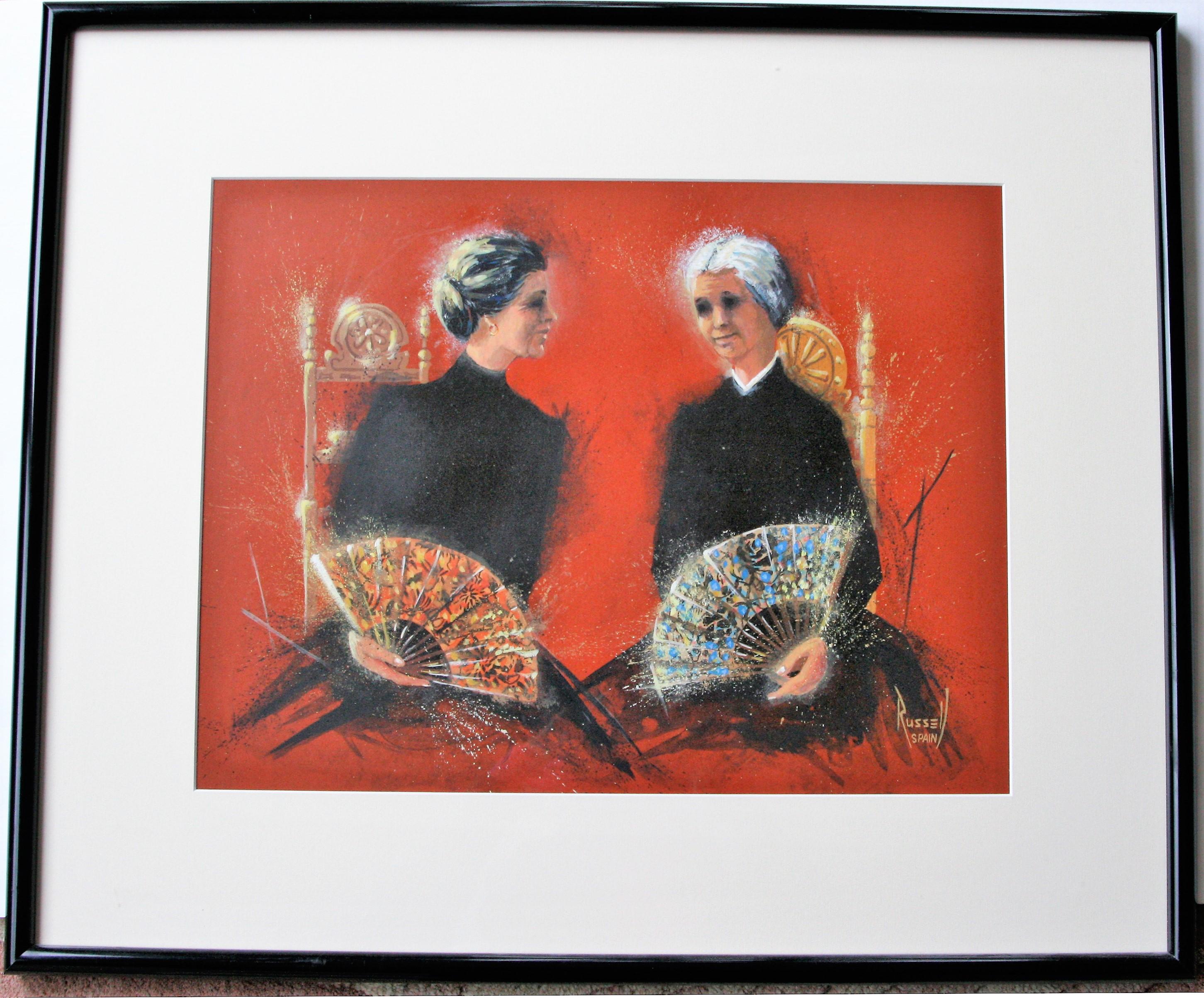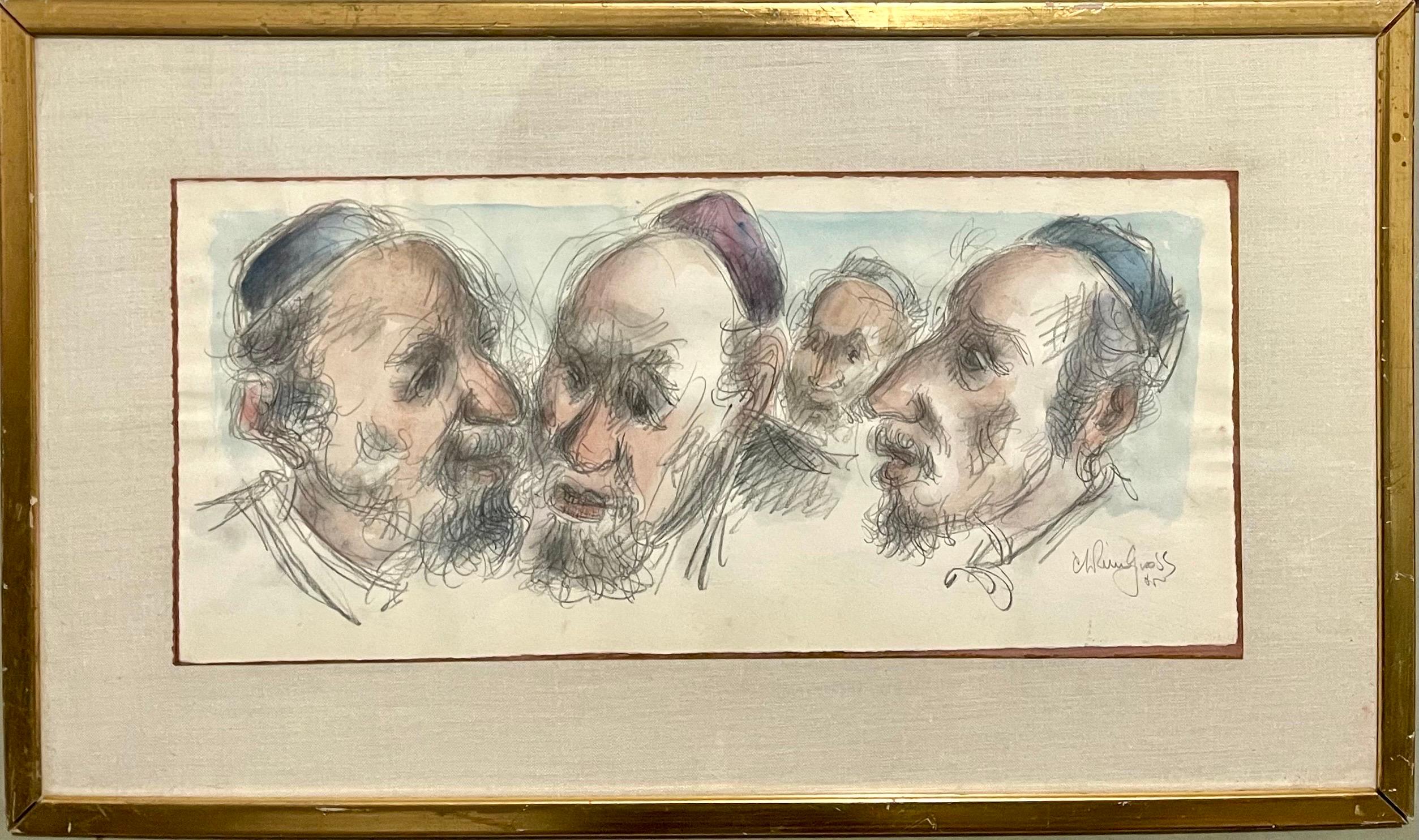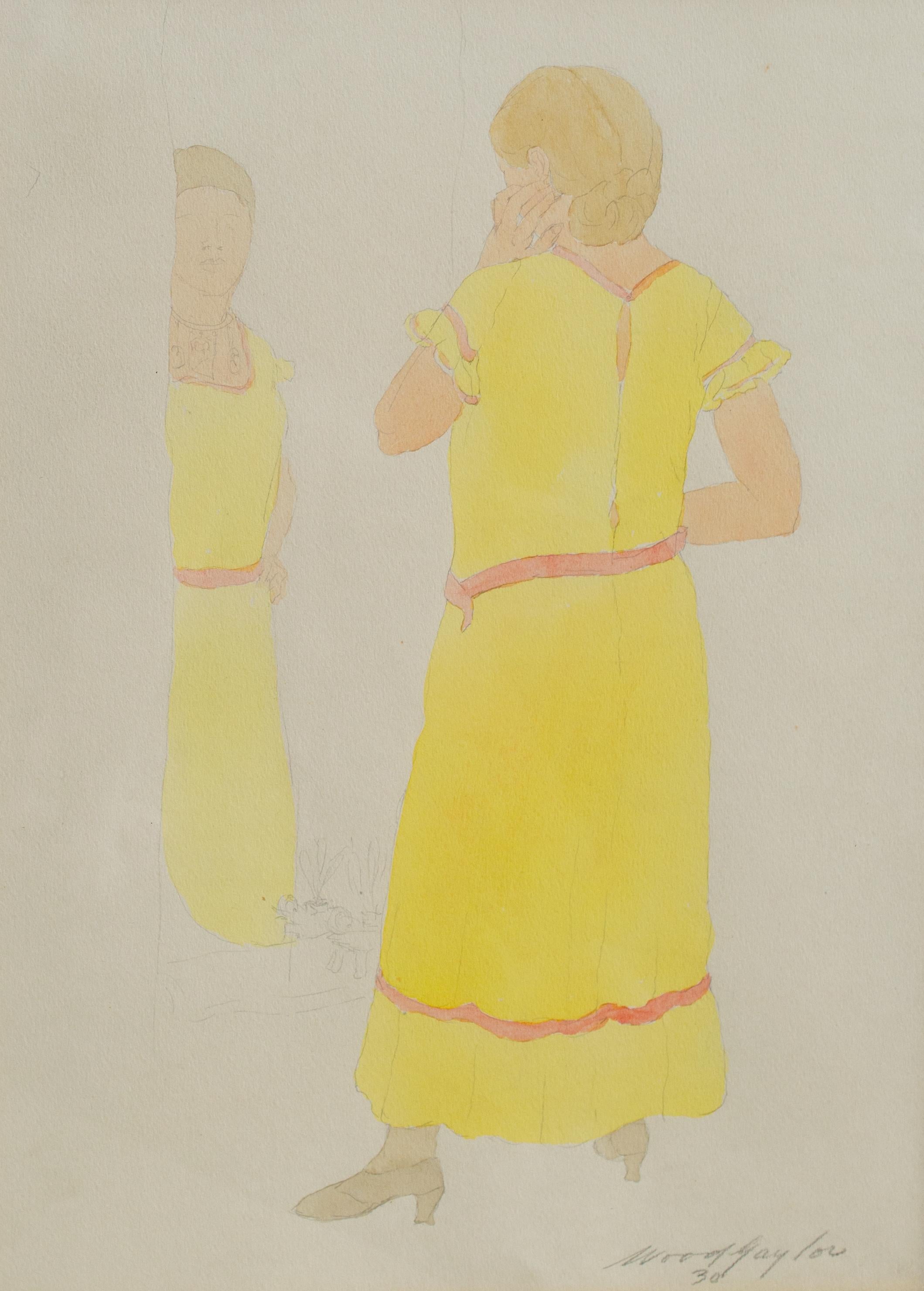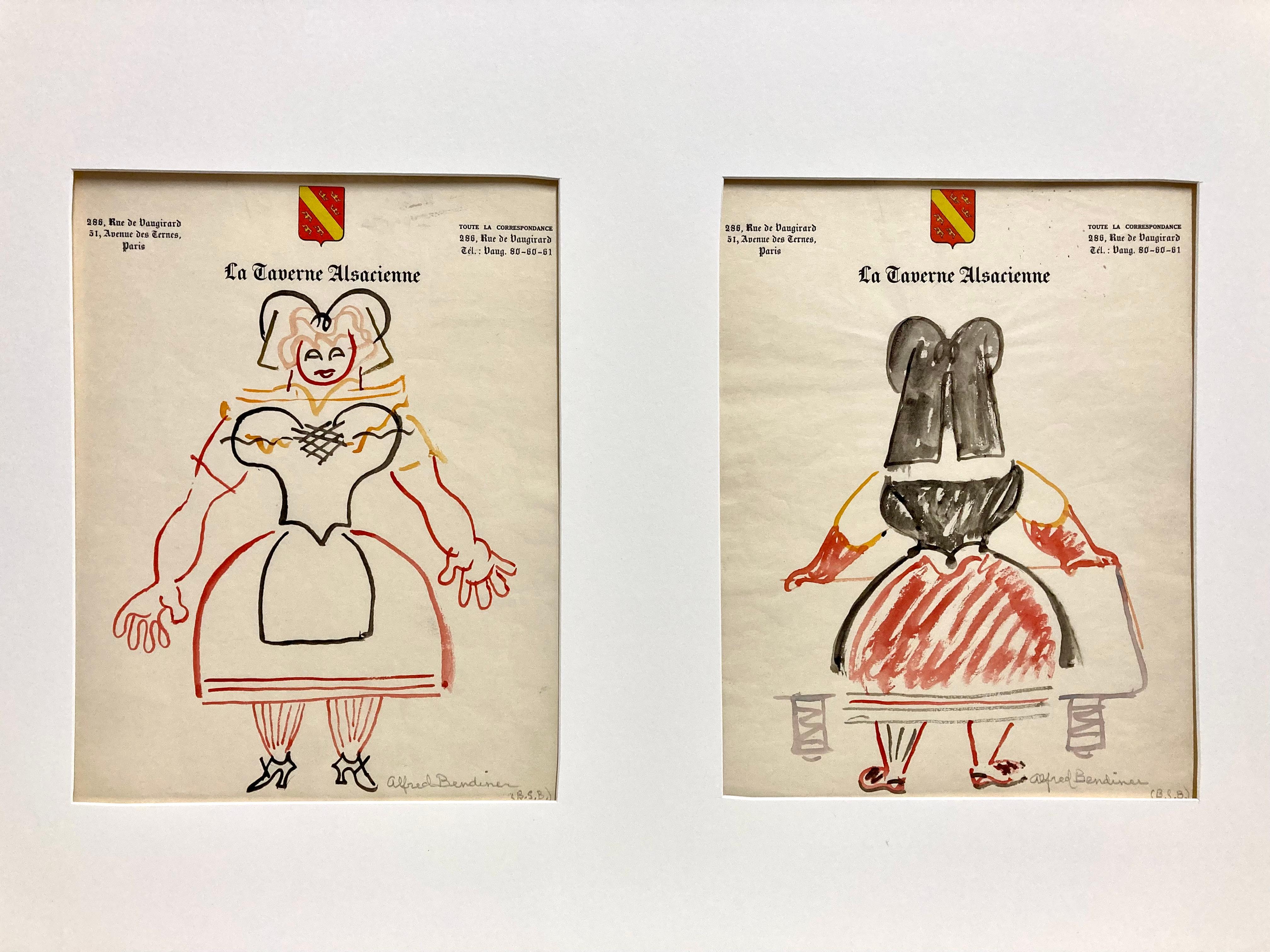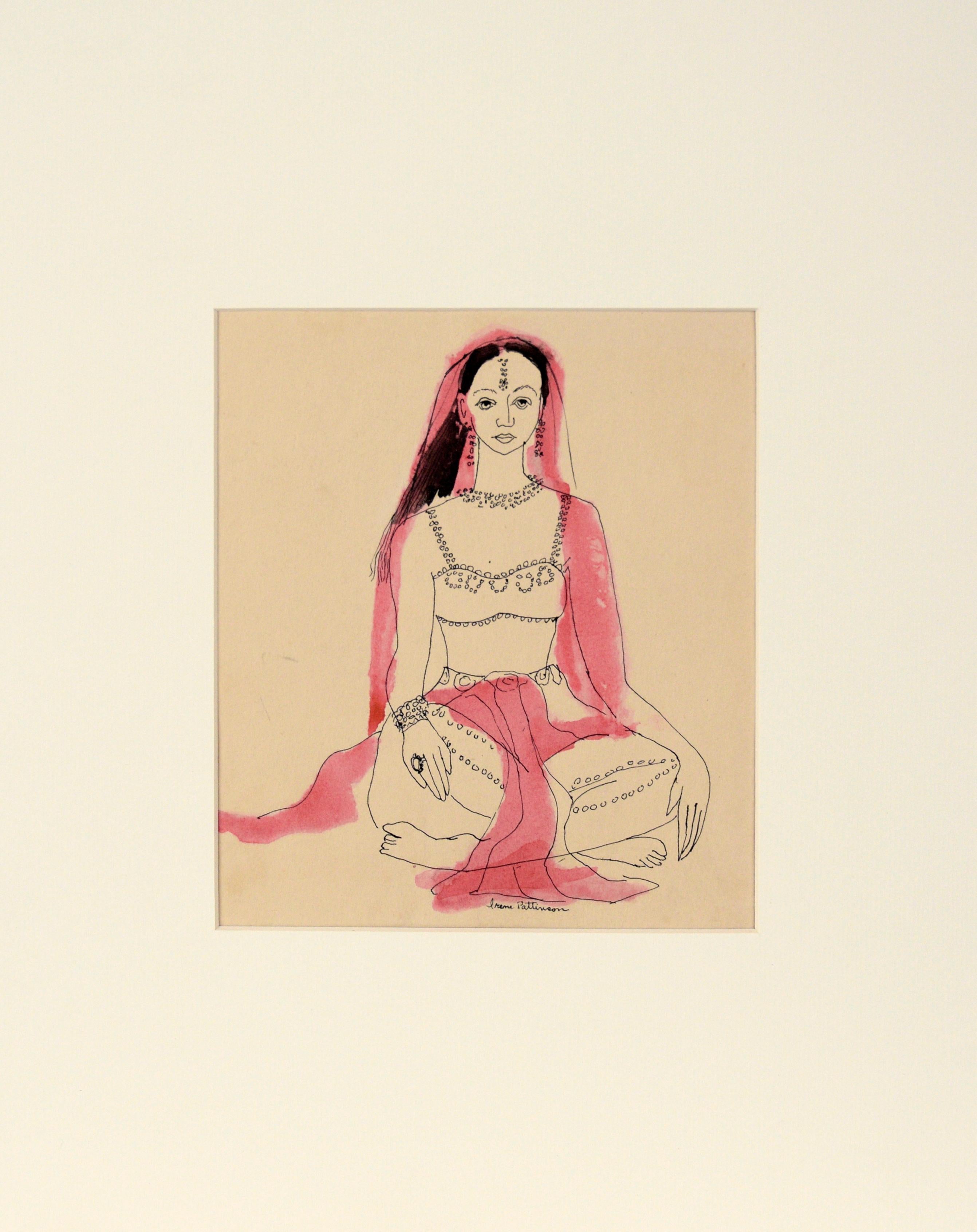Items Similar to Headdress Procession
Want more images or videos?
Request additional images or videos from the seller
1 of 9
Honore GuilbeauHeaddress Processionc 1950s
c 1950s
About the Item
Headdress Procession
Watercolor, c. 1950's
Signed by the artist in ink, lower right
The Headdress Procession occurs every year as part of the Christmas celebrations in Oaxaca.
Guilbeau first went to Mexico in the 1930s.
Provenance:
Joe Kisvardi, a close friend of Guilbeau
Honore Guilbeau
(1907-2006)
An American painter, printmaker and illustrator, Honore Guilbeau first began to exhibit her art in Cleveland and elsewhere around 1930. During the 1930's Depression era she worked mainly in the medium of lithography, contributing at least three such works of art to the Ohio Chapter of the Works Progress Administration (W.P.A.). Instituted by President Roosevelt, the W.P.A. actively assisted artists during this decade of hard economic times. From 1932-1937 Guilbeau was also commissioned on four separate occasions to provide prints for the Cleveland Print Makers “Print-a-Month” series.
During the 1940's and 1950's, Honore Guilbeau illustrated a number of fine books, including works for the Limited Editions Club. Among her works in this field were, Twain's, A Connecticut Yankee in King Arthur's Court, The Adventures of Hajji Baba (1947) and George Meredith's, The Shaving of Shagpat
Courtesy, Greg & Connie Peters
- Creator:Honore Guilbeau ((1907-2006), American)
- Creation Year:c 1950s
- Dimensions:Height: 20 in (50.8 cm)Width: 14 in (35.56 cm)
- Medium:
- Movement & Style:
- Period:
- Condition:
- Gallery Location:Fairlawn, OH
- Reference Number:
About the Seller
5.0
Recognized Seller
These prestigious sellers are industry leaders and represent the highest echelon for item quality and design.
Platinum Seller
These expertly vetted sellers are 1stDibs' most experienced sellers and are rated highest by our customers.
Established in 1978
1stDibs seller since 2013
712 sales on 1stDibs
Typical response time: 1 hour
Associations
International Fine Print Dealers Association
- ShippingRetrieving quote...Ships From: Fairlawn, OH
- Return PolicyA return for this item may be initiated within 10 days of delivery.
More From This SellerView All
- Study for "The Jade Necklace"By Joseph StellaLocated in Fairlawn, OHStudy for the painting "The Jade Necklace" Silver point drawing on prepared paper, n.d. Stamp lower right: "J Stella/JML Coll" (see photo) The painting of the...Category
20th Century American Modern Portrait Drawings and Watercolors
MaterialsPencil
- Dad Taught Me to Be Brave, No. 3By Darius StewardLocated in Fairlawn, OHDad Taught Me to Be Brave , No. 3 (Hand touching lips) Signed with the artist's initials. Watercolor on Yupo paper Series: Dad Taught Me to Be Brave (3 waterc...Category
2010s Contemporary Portrait Drawings and Watercolors
MaterialsWatercolor
- Stolen Moments #2By Darius StewardLocated in Fairlawn, OHStolen Moments #2 Watercolor on Twinrocker All Purpose Paper Signed with the artist's initials lower right (see photo) From the series: Stolen Moments Signed with the artist's "Yummy...Category
2010s Contemporary Portrait Drawings and Watercolors
MaterialsWatercolor
- "R"By Darius StewardLocated in Fairlawn, OHSigned with the artist's initials lower right From: MORE? Series (5 works) Exhibited: Canton Museum of Art "Darius Steward: Our Separated Selves" August 16 - October 27, 2018 (labe...Category
2010s Contemporary Portrait Drawings and Watercolors
MaterialsWatercolor
- Stolen Moments #3By Darius StewardLocated in Fairlawn, OHSigned with the artist's initials lower right From the Series: Stolen Moments Signed with the artist's "Yummy" blindstamp lower right Note: Darius Steward is establishing himself...Category
2010s Contemporary Portrait Drawings and Watercolors
MaterialsWatercolor
- Going Places #2 (Baggage Claim)By Darius StewardLocated in Fairlawn, OHWatercolor on Yupo Signed by the artist DRS #1, lower right.Category
2010s Contemporary Figurative Drawings and Watercolors
MaterialsWatercolor
You May Also Like
- Two Dueñas.By Donn RussellLocated in Storrs, CTTwo Dueñas. c. 1960. Watercolor and gouache. 13 x 17. Signed and annotated 'SPAIN' lower right. Housed in a 21 x 25-inch black wood frame. Donn Russell is one of Nantucket Island's...Category
1950s American Modern Portrait Drawings and Watercolors
MaterialsWatercolor, Gouache
- Chaim Gross Mid Century Mod Judaica Jewish Watercolor Painting Rabbis WPA ArtistBy Chaim GrossLocated in Surfside, FLChaim Gross (American, 1904-1991) Watercolor painting Rabbinical Talmudic Discussion Hand signed 17 x 29 framed, paper 10 x 22 Chaim Gross (March 17, 1904 – May 5, 1991) was an American modernist sculptor and educator. Gross was born to a Jewish family in Austrian Galicia, in the village of Wolowa (now known as Mezhgorye, Ukraine), in the Carpathian Mountains. In 1911, his family moved to Kolomyia (which was annexed into the Ukrainian USSR in 1939 and became part of newly independent Ukraine in 1991). When World War I ended, Gross and brother Avrom-Leib went to Budapest to join their older siblings Sarah and Pinkas. Gross applied to and was accepted by the art academy in Budapest and studied under the painter Béla Uitz, though within a year a new regime under Miklos Horthy took over and attempted to expel all Jews and foreigners from the country. After being deported from Hungary, Gross began art studies at the Kunstgewerbeschule in Vienna, Austria shortly before immigrating to the United States in 1921. Gross's studies continued in the United States at the Beaux-Arts Institute of Design, where he studied with Elie Nadelman and others, and at the Art Students League of New York, with Robert Laurent. He also attended the Educational Alliance Art School, studying under Abbo Ostrowsky, at the same time as Moses Soyer and Peter Blume. In 1926 Gross began teaching at The Educational Alliance, and continued teaching there for the next 50 years. Louise Nevelson was among his students at the Alliance (in 1934), during the time she was transitioning from painting to sculpture. In the late 1920s and early 1930s he exhibited at the Salons of America exhibitions at the Anderson Galleries and, beginning in 1928, at the Whitney Studio Club. In 1929, Gross experimented with printmaking, and created an important group of 15 linocuts and lithographs of landscapes, New York City streets and parks, women in interiors, the circus, and vaudeville. The entire suite is now in the collection of the Philadelphia Museum of Art. Gross returned to the medium of printmaking in the 1960s, and produced approximately 200 works in the medium over the next two decades. For more than sixty years Chaim Gross's art has expressed optimistic, affirming themes, Judaica, balancing acrobats, cyclists, trapeze artists and mothers and children convey joyfulness, modernism, exuberance, love, and intimacy. This aspect of his work remained consistent with his Jewish Hasidic heritage, which teaches that only in his childlike happiness is man nearest to God. In March 1932 Gross had his first solo exhibition at Gallery 144 in New York City. For a short time they represented Gross, as well as his friends Milton Avery, Moses Soyer, Ahron Ben-Shmuel and others. Gross was primarily a practitioner of the direct carving method, with the majority of his work being carved from wood. Other direct carvers in early 20th-century American art include William Zorach, Jose de Creeft, and Robert Laurent. Works by Chaim Gross can be found in major museums and private collections throughout the United States, with substantial holdings (27 sculptures) at the Hirshhorn Museum and Sculpture Garden. A key work from this era, now at the Smithsonian American Art Museum, is the 1932 birds-eye maple Acrobatic Performers, which is also only one and one quarter inch thick. In 1933 Gross joined the government's PWAP (Public Works of Art Project), which transitioned into the WPA (Works Progress Administration), which Gross worked for later in the 1930s. Under these programs Gross taught and demonstrated art, made sculptures that were placed in schools and public colleges, made work for Federal buildings including the Federal Trade Commission Building, and for the France Overseas and Finnish Buildings at the 1939 New York World's Fair. Gross was also recognized during these years with a silver medal at the Exposition universelle de 1937 in Paris, and in 1942, with a purchase prize at the Metropolitan Museum of Art's "Artists for Victory" exhibition for his wood sculpture of famed circus performer Lillian Leitzel. In 1949 Gross sketched Chaim Weizmann, Israeli President, at several functions in New York City where Weizmann was speaking, Gross completed the bust in bronze later that year. Gross returned to Israel for three months in 1951 (the second of many trips there in the postwar years) to paint a series of 40 watercolors of life in various cities. This series was exhibited at the Jewish Museum (Manhattan) in 1953. He also did some important Hebrew medals. In the 1950s Gross began to make more bronze sculptures alongside his wood and stone pieces, and in 1957 and 1959 he traveled to Rome to work with famed bronze foundries including the Nicci foundry. At the end of the decade Gross was working primarily in bronze which allowed him to create open forms, large-scale works and of course, multiple casts. Gross's large-scale bronze The Family, donated to New York City in 1991 in honor of Mayor Ed Koch, and installed at the Bleecker Street Park at 11th street, is now a fixture of Greenwich Village. In 1959, a survey of Gross's sculpture in wood, stone, and bronze was featured in the exhibit Four American Expressionists curated by Lloyd Goodrich at the Whitney Museum of American Art, with work by Abraham Rattner, Doris Caesar, and Karl Knaths. In 1976, a selection from Gross's important collection of historic African sculpture, formed since the late 1930s, was exhibited at the Worcester Art Museum in the show The Sculptor's Eye: The African Art Collection of Mr. and Mrs. Chaim Gross. Gross was elected into the National Academy of Design as an Associate member, and became a full Academician in 1981. In 1984, he was inducted into the American Academy of Arts and Letters, with Jacob Lawrence and Lukas Foss. In the fall of 1991, Allen Ginsberg gave an important tribute to Gross at the American Academy of Arts and Letters, which is published in their Proceedings. In 1994, Forum Gallery, which now represents the Chaim Gross estate, held a memorial exhibition featuring a sixty-year survey of Gross's work.In March 1932 Gross had his first solo exhibition at Gallery 144 in New York City. For a short time they represented Gross, as well as his friends Milton Avery, Moses Soyer, Ahron Ben-Shmuel and others. Gross was primarily a practitioner of the direct carving method, with the majority of his work being carved from wood. Other direct carvers in early 20th-century American art include William Zorach, Jose de Creeft, and Robert Laurent. Works by Chaim Gross can be found in major museums and private collections throughout the United States, with substantial holdings (27 sculptures) at the Hirshhorn Museum and Sculpture Garden. A key work from this era, now at the Smithsonian American Art Museum, is the 1932 birds-eye maple Acrobatic Performers, which is also only one and one quarter inch thick. In 1933 Gross joined the government's PWAP (Public Works of Art Project), which transitioned into the WPA (Works Progress Administration), which Gross worked for later in the 1930s. Under these programs Gross taught and demonstrated art, made sculptures that were placed in schools and public colleges, made work for Federal buildings including the Federal Trade Commission Building, and for the France Overseas and Finnish Buildings at the 1939 New York World's Fair. Gross was also recognized during these years with a silver medal at the Exposition universelle de 1937 in Paris, and in 1942, with a purchase prize at the Metropolitan Museum of Art's "Artists for Victory" exhibition for his wood sculpture of famed circus performer Lillian Leitzel. In 1949 Gross sketched Chaim Weizmann, President of Israel, at several functions in New York City where Weizmann was speaking, Gross completed the bust in bronze later that year. Gross returned to Israel for three months in 1951 (the second of many trips there in the postwar years) to paint a series of 40 watercolors of life in various cities. This series was exhibited at the Jewish Museum (Manhattan) in 1953. In the 1950s Gross began to make more bronze sculptures alongside his wood and stone pieces, and in 1957 and 1959 he traveled to Rome to work with famed bronze foundries including the Nicci foundry. At the end of the decade Gross was working primarily in bronze which allowed him to create open forms, large-scale works and of course, multiple casts. Gross's large-scale bronze The Family, donated to New York City in 1991 in honor of Mayor Ed Koch, and installed at the Bleecker Street Park at 11th street, is now a fixture of Greenwich Village. In 1959, a survey of Gross's sculpture in wood, stone, and bronze was featured in the exhibit Four American Expressionists curated by Lloyd Goodrich at the Whitney Museum of American Art, with work by Abraham Rattner, Doris Caesar, and Karl Knaths. In 1976, a selection from Gross's important collection of historic African sculpture, formed since the late 1930s, was exhibited at the Worcester Art Museum in the show The Sculptor's Eye: The African Art Collection of Mr. and Mrs. Chaim Gross. Gross was elected into the National Academy of Design as an Associate member, and became a full Academician in 1981. In 1984, he was inducted into the American Academy of Arts and Letters, with Jacob Lawrence and Lukas Foss. In the fall of 1991, Allen Ginsberg gave an important tribute to Gross at the American Academy of Arts and Letters, which is published in their Proceedings. In 1994, Forum Gallery, which now represents the Chaim Gross estate, held a memorial exhibition featuring a sixty-year survey of Gross's work. Gross was a professor of printmaking and sculpture at both the Educational Alliance and the New School for Social Research in New York City, as well as at the Brooklyn Museum Art School, the MoMA art school, the Art Student's League and the New Art School (which Gross ran briefly with Alexander Dobkin...Category
Mid-20th Century American Modern Figurative Drawings and Watercolors
MaterialsPaper, Watercolor
- Samuel Wood Gaylor American Modernist WatercolorLocated in Larchmont, NYSamuel Wood Gaylor (American, 1883 - 1957) Untitled (Woman in Mirror), 1930 Watercolor on paper Sight size: 14 1/4 x 10 1/4 in. Framed: 20 3/4 x 16 1/4 in...Category
1930s American Modern Portrait Drawings and Watercolors
MaterialsPaper, Watercolor
- Alfred Bendiner, La Alsacienne (pair)By Alfred BendinerLocated in New York, NYLeave it to the Bendiners to find an Alsatian restaurant in Paris (La Taverne Alsacienne) and use it's stationary to such a great end! And thank goodness that the paper required two ...Category
1960s American Modern Figurative Drawings and Watercolors
MaterialsWatercolor
- Alfred Bendiner, (Baseball Hitter and Pitcher -- The Philadelphia Phillies?)By Alfred BendinerLocated in New York, NYOf course it's possible that these baseball players aren't from a Philadelphia team, but I doubt it. There was so much drama and intrigue with both the Philadelphia Phillies and the ...Category
Mid-20th Century American Modern Figurative Drawings and Watercolors
MaterialsIndia Ink, Watercolor
- Indian Dancer - Vintage Illustration in Ink and WatercolorBy Irene PattinsonLocated in Soquel, CAIndian Dancer - Vintage Illustration in Ink and Watercolor A stoic, dark-haired woman in elaborate dress is sitting cross-legged in this illustration by Irene Pattinson (American, 1909-1999). Pattinson uses fine ink line detail and a vibrant pink watercolor for a splash of color. Signed at the bottom, "Irene Pattinson." Provenance: The Artist, Estate of Irene Pattinson: David Carlson; Estate of Larry Miller Fine Art, Robert Azensky Fine Art. Presented in a new white mat with foam core backing. Mat size: 16"H x 12"W Paper size: 11.75"H x 8.5"W Image size: 7.5"H x 6.5"W Irene Pattinson (American, 1909-1999) studied at the California School of Fine Art (now The San Francisco Art Institute), San Francisco State College and The Marion Hartwell School of Design. She was President of the San Francisco Woman Artists Association 1955-56. Provenance: The Artist, Estate of Irene Pattinson: David Carlson; Estate of Larry Miller Fine Art, Robert Azensky Fine Art. Solo Exhibitions: Lucien Labaudt Gallery 1955; San Francisco Museum of Art, 1961 (39 works). Selected Group Exhibitions: San Francisco Art Association Annual 1948, 54, 55; San Francisco Woman Artists, 1957-1960; Oakland Art Museum Annual, 1951, 58; California Palace of the Legion of Honor, 1960; Richmond Art Center, 1955, 56, 57, 58; San Francisco Art Institute 1959, 60. The Art Bank of the San Francisco Art Association, 1958, 59, 60, 62, 63; Winter Invitational, California Palace of The Legion of Honor, San Francisco, 1960; Fourth Winter Invitational, California Palace of The Legion of Honor, San Francisco, 1963. Awards: First Place, San Francisco Woman Artists Assoc., 1957, 1959; San Francisco Art Festival 1957;Literature: San Francisco Art Institute - A catalog of the Art Ban 1962/63; San Francisco and the Second Wave: The Blair Collection Exhibitions: 1963 The Art Bank of the San Francisco Art Association, San Francisco, CA 1963 California Palace of The Legion of Honor: Forth Winter Invitational, San Francisco, CA 1962 The Art Bank of the San Francisco Art Association, San Francisco, CA 1961 San Francisco Museum of Art, San Francisco, CA 1960 California...Category
1950s American Modern Figurative Drawings and Watercolors
MaterialsIndia Ink, Paper, Watercolor, Pen
Recently Viewed
View AllMore Ways To Browse
Crete Greece
Indian Railways
French Cafe Plate
1960s Stanley Blacker
St John Statue
Oil Painting Long Island Sound
Recent Abstract Painting Sales
Concept Bicycle
Fiberglass Screens
Cow Painting Gilt Frame
Marc Chagall Signed Moses
Black And White Fruit Bowl
Jackson Graham
Earliest Horizons
Jam S
Paul Kasmin
Walter Meyer
Dancing Cow
